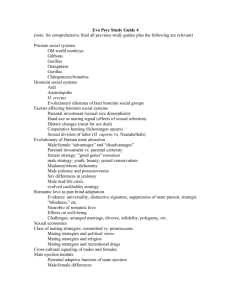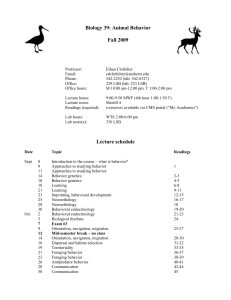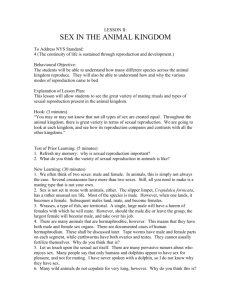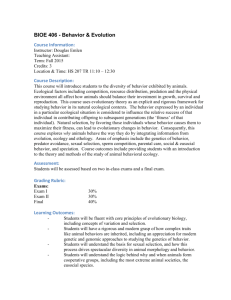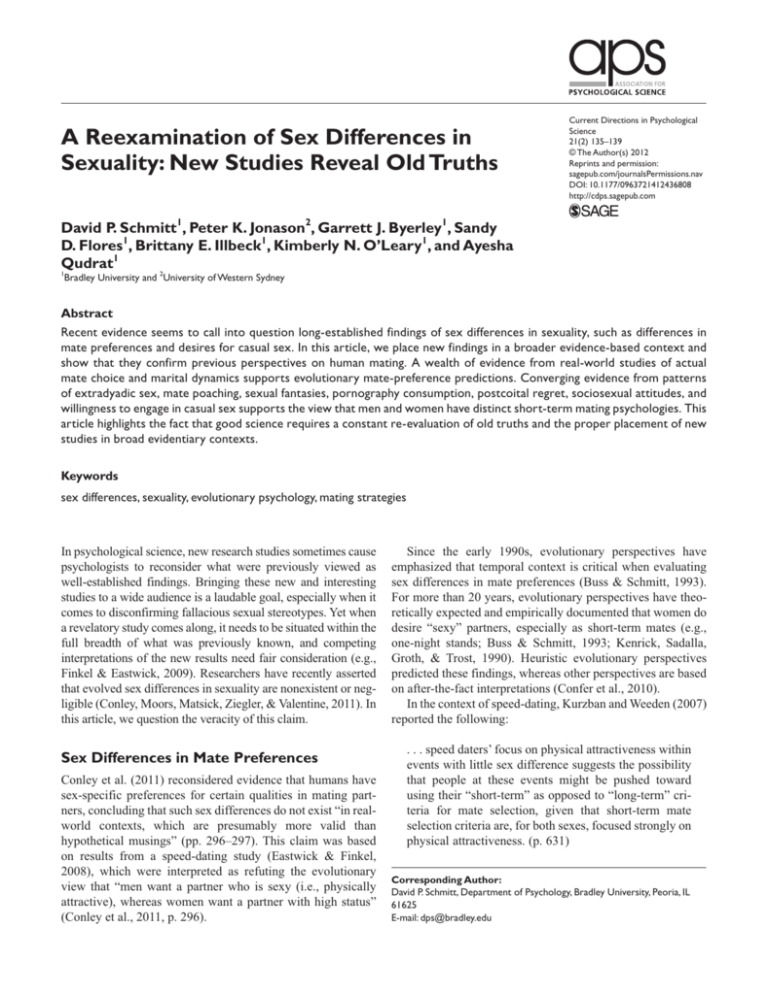
XXX10.1177/0963721412436808
2012
A Reexamination of Sex Differences in
Sexuality: New Studies Reveal Old Truths
Current Directions in Psychological
Science
21(2) 135­–139
© The Author(s) 2012
Reprints and permission:
sagepub.com/journalsPermissions.nav
DOI: 10.1177/0963721412436808
http://cdps.sagepub.com
David P. Schmitt1, Peter K. Jonason2, Garrett J. Byerley1, Sandy
D. Flores1, Brittany E. Illbeck1, Kimberly N. O’Leary1, and Ayesha
Qudrat1
1
Bradley University and 2University of Western Sydney
Abstract
Recent evidence seems to call into question long-established findings of sex differences in sexuality, such as differences in
mate preferences and desires for casual sex. In this article, we place new findings in a broader evidence-based context and
show that they confirm previous perspectives on human mating. A wealth of evidence from real-world studies of actual
mate choice and marital dynamics supports evolutionary mate-preference predictions. Converging evidence from patterns
of extradyadic sex, mate poaching, sexual fantasies, pornography consumption, postcoital regret, sociosexual attitudes, and
willingness to engage in casual sex supports the view that men and women have distinct short-term mating psychologies. This
article highlights the fact that good science requires a constant re-evaluation of old truths and the proper placement of new
studies in broad evidentiary contexts.
Keywords
sex differences, sexuality, evolutionary psychology, mating strategies
In psychological science, new research studies sometimes cause
psychologists to reconsider what were previously viewed as
well-established findings. Bringing these new and interesting
studies to a wide audience is a laudable goal, especially when it
comes to disconfirming fallacious sexual stereotypes. Yet when
a revelatory study comes along, it needs to be situated within the
full breadth of what was previously known, and competing
interpretations of the new results need fair consideration (e.g.,
Finkel & Eastwick, 2009). Researchers have recently asserted
that evolved sex differences in sexuality are nonexistent or negligible (Conley, Moors, Matsick, Ziegler, & Valentine, 2011). In
this article, we question the veracity of this claim.
Sex Differences in Mate Preferences
Conley et al. (2011) reconsidered evidence that humans have
sex-specific preferences for certain qualities in mating partners, concluding that such sex differences do not exist “in realworld contexts, which are presumably more valid than
hypothetical musings” (pp. 296–297). This claim was based
on results from a speed-dating study (Eastwick & Finkel,
2008), which were interpreted as refuting the evolutionary
view that “men want a partner who is sexy (i.e., physically
attractive), whereas women want a partner with high status”
(Conley et al., 2011, p. 296).
Since the early 1990s, evolutionary perspectives have
emphasized that temporal context is critical when evaluating
sex differences in mate preferences (Buss & Schmitt, 1993).
For more than 20 years, evolutionary perspectives have theoretically expected and empirically documented that women do
desire “sexy” partners, especially as short-term mates (e.g.,
one-night stands; Buss & Schmitt, 1993; Kenrick, Sadalla,
Groth, & Trost, 1990). Heuristic evolutionary perspectives
predicted these findings, whereas other perspectives are based
on after-the-fact interpretations (Confer et al., 2010).
In the context of speed-dating, Kurzban and Weeden (2007)
reported the following:
. . . speed daters’ focus on physical attractiveness within
events with little sex difference suggests the possibility
that people at these events might be pushed toward
using their “short-term” as opposed to “long-term” criteria for mate selection, given that short-term mate
selection criteria are, for both sexes, focused strongly on
physical attractiveness. (p. 631)
Corresponding Author:
David P. Schmitt, Department of Psychology, Bradley University, Peoria, IL
61625
E-mail: dps@bradley.edu
136
The special nature of speed-dating interactions also may
reflect an early stage of attraction in which only superficial
cues, such as physical attractiveness, are available. Even so, at
least some long-term mate preferences are operative, as several speed-dating studies, especially those using community
sampling, have found that women’s, but not men’s, actual
choices are affected by a partner’s status-related attributes,
such as education, income, and intelligence (Asendorpf,
Penke, & Back, 2011; Fisman, Iyengar, Kamenica, & Simonson, 2006; Todd, Penke, Fasolo, & Lenton, 2007).
Even if Conley et al. (2011) had conceptually limited their
skepticism to sex differences in long-term mate preferences, a
proper scientific re-evaluation of evolutionary predictions
requires the acknowledgment of previous investigations into
real-world mating. Several studies of actual marital choice
have found that women (but not men) tend to marry partners
who are higher than average in terms of status and resources,
whereas men (but not women) tend to marry partners who are
younger than they are and possess cues signaling higher fertility (Bereczkei & Csanaky, 1996; Kenrick & Keefe, 1992;
Perusse, 1994). Importantly, these preferences do not dissipate
after people marry (Shackelford, Schmitt, & Buss, 2005a), and
they demonstrably influence marital satisfaction, retention
efforts, infidelity, jealousy, and divorce (e.g., McNulty, Neff,
& Karney, 2008). Sex differences in preferences for physical
attractiveness and status-related attributes in long-term mates
have been documented in real-life personal ads, responses to
personal ads, and online dating choices (e.g., Feingold, 1992);
in nationally representative samples (Sprecher, Sullivan, &
Hatfield, 1994); in large cross-cultural studies (Shackelford,
Schmitt, & Buss, 2005b); in studies of older adults (Alterovitz
& Mendelsohn, 2011); and in many studies that experimentally test for the natural cognitive consequences (e.g., contrast
effects) of these mate preferences (Campbell & Wilbur, 2009;
Kenrick, Neuberg, Zierk, & Krones, 1994; Roney, 2003).
Also relevant for evaluating the new findings are the subtle
differences among preferred, ideal, necessary, and minimally
acceptable levels of marriage-partner qualities (Kenrick et al.,
1990) and the critical roles of trade-offs and the ways in which
one’s own mate value affects mate choice (Li, Bailey, Kenrick,
& Linsenmeier, 2002), especially in real-world speed-dating
contexts (Back, Penke, Schmukle, & Asendorpf, 2011; Todd
et al., 2007). Decades of fieldwork by anthropologists, biologists, and behavioral ecologists have further confirmed the
influence of physical attractiveness and status on real-world
mate choice, dowry payments, and fertility outcomes (Buss,
2003; Hopcroft, 2006).
It is reasonable to expect that some explicitly stated preferences play less of a role in mate choice than people consciously
assume, in part because some preference mechanisms are
clearly outside of conscious awareness (Pillsworth & Haselton, 2006; Thornhill & Gangestad, 2008). In general, the
degree to which conscious preferences influence mate choice
probably depends on the specific characteristic under study
(e.g., resources, status, ambition, dominance), the type of
Schmitt et al.
relationship sought (e.g., one-night stand, brief affair, dating,
marriage), the effects of one’s mate value and local sex ratios,
and other factors, such as religion and kin, that cause people to
not always strive for what they think they want (see Burris,
Welling, & Puts, 2011). In terms of preferences for physical
attractiveness and status-related attributes in mates, many of
these caveats were rightly noted by Eastwick and Finkel
(2008): “It would be a tremendous stretch from the current
data to suggest that physical attractiveness or earning prospects are never associated with sex-differentiated romantic
interest in actual dating partners” (p. 262).
New studies can be scientifically illuminating when properly compared against the cumulative weight of existing evidence (e.g., Kurzban & Weeden, 2007). However, Conley
et al. (2011) portrayed a single study as failing to support evolutionary predictions in speed dating and did not address the
immense foundation of evidence supporting sex-linked preferences for physical attractiveness and status, yet they definitively resolved that no sex differences exist in real-world mate
preferences. Such disregard of extant evidence in a review
could seriously inhibit progress in this area of sexual science
(Ketelaar & Ellis, 2000).
Sex Differences in Desired Number
of Sex Partners
Conley et al. (2011) also reconsidered whether women desire
(and have) fewer sexual partners than men do, concluding that
such sex differences are artifacts of “inappropriate statistics
and social desirability” rather than reflections of underlying
psychological differences. In the context of desired numbers
of partners, Conley et al. (2011) cited Pedersen, Miller,
Putcha-Bhagavatula, and Yang (2002). Numerous studies have
addressed problems with Pedersen et al. (2002), including the
inappropriate use of the Maritz-Jarrett median test (this statistic allows distributional skew to bias significance testing;
Schmitt et al., 2003), failures in replicating the absence of significant median-based sex differences (Fenigstein & Preston,
2007), failures in addressing the tails of men’s and women’s
distributions (McBurney, Zapp, & Streeter, 2005), and problems with the conceptual misconstrual of sexual-strategies
theory (Schmitt et al., 2003).
Sexual-strategies theory does not predict that most men
will seek large numbers of partners or that few women will
seek short-term mates (see also Gangestad & Simpson, 2000).
Rather, it predicts that when men are actively seeking shortterm mates, they should tend to seek larger numbers of sexual
partners than women should when they are actively seeking
short-term mates. It is because of the psychological shifts that
occur within men and within women when they choose to pursue a short-term mating strategy (as opposed to a long-term
mating strategy) that researchers can compare the sexes and
expect overall differences across their distributions of desired
number of sex partners. When examined in this proper context, repeated cross-cultural tests have shown that men’s and
Sex Differences in Sexuality
women’s desired number of sex partners are not the same; for
example, Schmitt et al. (2003) found that about 25% of men
but only 5% of women want “more than one” sexual partner in
the next month.
None of these important published correctives to Pedersen
et al. (2002) were noted by Conley et al. (2011), nor was the
wealth of converging evidence of sex differences in desired
numbers of short-term sexual partners—such as robust and
reliable sex differences in desiring multiple partners for
extradyadic sex, short-term mate poaching, sexual fantasies,
and pornography consumption, as well as level of postcoital
regret, time needed before consenting to sex, and attitudes
toward engaging in casual sex (for a review, see Buss &
Schmitt, 2011). Sex differences in permissive sociosexuality
(e.g., agreeing with the statement, “Sex without love is OK”)
were universally observed across 53 nations (Lippa, 2009). A
meta-analysis of sex differences in sexuality (Petersen &
Hyde, 2010) concluded, “In support of evolutionary psychology, results from both the individual studies and the large data
sets indicated that men reported . . . more permissive attitudes
than women for most of the variables” (p. 21) and “evolutionary psychology proposes that short-term mating strategies are
associated with significant gender differences. . . . Results
from the current study support this theory” (p. 35). It is unclear
how a scientific review of evidence on this topic could lead to
the strong assertion that sex differences in desired number of
short-term sexual partners are negligible.
Sex Differences in Attitudes
Toward Casual Sex
Conley et al. (2011) contended that results from Conley (2011)
should lead psychologists to reconsider whether sex differences exist in liking casual sex, concluding in part that such
sex differences are mediated by the proposers’ “sexual capabilities.” Conley et al. (2011) explained that apparent sex differences in casual-sex attitudes and behaviors—repeatedly
observed in previous surveys, meta-analyses, and real-world
experiments—are confounded with factors other than the sex
of the desirer—namely, the sex of the potential casual-sex
partner. In particular, Conley (2011) reported that the perceived sexual capabilities of strangers mediate sex differences
in positive reactions to casual-sex offers. This very interesting
finding may help to elucidate proximate mechanisms leading
men to adaptively consent to casual-sex offers more than
women do. However, there are serious problems with considering this finding as being in direct opposition to functional or
ultimate levels of explanation or as a refutation of all previous
evidence of sex differences in liking casual sex.
First, on the basis of the assumption that “[sexual] offers
from women are accepted more often than offers from men”
(p. 310), Conley (2011) reasoned that men are more likely to
perceive women who make sexual offers as sexually skilled
and therefore able to provide more sexual pleasure. This is a
critical assumption, but it leads to circular reasoning. The fact
137
that men have accepted more sexual offers in the past is a central antecedent for Conley’s (2011) assertion that men will
expect in the future to have more sexual pleasure from sex
with strangers (i.e., men having accepted offers in the past is
required for short-term interested women to have developed
more sexual skill). Without this assumption, the differences in
proposers’ sexual capabilities cannot exist and cannot appear
to mediate why men accept more sexual offers in the present.
Conley (2011) both assumes the existence of “actual” sex differences in accepting casual-sex offers and attempts to explain
away “apparent” sex differences in accepting casual-sex offers
by introducing a mediational variable. The perceived differences in sexual skill of proposers may well be accurate, but
what caused men to accept more sexual offers in the first
place? Conley’s (2011) mediational explanation begs the question of a first cause of men’s greater willingness to accept
offers for sex. A well-supported possibility for this first cause
is the existence of evolved preferences in men for easy sexual
access when short-term mating (Buss & Schmitt, 1993).
Second, Conley (2011) reported that women were much
more likely than men to agree to a brief sexual encounter with
a high-profile celebrity (e.g., Brad Pitt, Johnny Depp, Angelina Jolie, Jennifer Lopez) compared with an unknown
stranger. Although Conley (2011) claimed that this “eliminated” sex differences in willingness to have casual sex, this
finding likely resulted from women’s (but not men’s) shortterm mating psychology being specially designed to obtain
good genes from physically attractive short-term partners
(Thornhill & Gangestad, 2008). Indeed, investigators have
found with people’s actual real-world responses to sexual
offers that women, but not men, are affected by the physical
attractiveness of the proposer (Hald & Høgh-Olesen, 2010).
Had Conley (2011) restricted her samples to only preovulatory
women who were already in relationships with asymmetrical
and submissive partners, it is quite possible women would
have appeared more interested than men in having sex with
celebrity strangers, as such findings would be fully in line with
evolutionary perspectives on short-term mating (Pillsworth &
Haselton, 2006).
Third, Conley (2011) had participants (22 years of age on
average) consider sex with much older celebrities who were
married. Women in their 20s generally prefer older partners as
short-term mates than men do (Buunk, Dijkstra, Kenrick, &
Warntjes, 2001); women tend to find already-mated prospective partners especially attractive (Parker & Burkley, 2009);
and when mate poaching, women do not face extreme dangers
from other men’s sexual jealousy (Buss, 2003). Perhaps
a fairer consideration for college-aged participants would
involve casual sex with contemporary same-aged, single
celebrities, such as Michael Cera or Ellen Page.
Regardless, Conley’s (2011) accumulated empirical evidence was largely consistent with evolutionary theories of sex
differences in short-term mating psychology. Modern evolutionary psychology views many of women’s sexual desires
and behaviors as adaptively designed for pursuing a
138
short-term sexual strategy (in some ways, women’s short-term
mating psychology is even more “specially designed” than is
men’s more indiscriminate and opportunistic short-term mating psychology). When women’s short-term-mating aim is
activated (perhaps temporarily, because of, e.g., high-fertility
ovulatory status or desire for an extramarital affair, or more
chronically, because of, e.g., a female-biased local sex ratio or
a history of insecure parent-child attachment), they appear to
express relatively focused desires for genetic traits in “sexy
men” that would biologically benefit women when short-term
mating (Thornhill & Gangestad, 2008). Regrettably, some
researchers mistakenly interpret these new evolutionarily
stimulated findings as signifying that there are no sex differences in permissive sexuality at all. Progress in psychological
science is stalled by these errors of understanding.
Conclusions
However much predictive successes established theories and
hypotheses may have, Popperian science requires us to be ever
vigilant for new evidence that could refute them. Conley et al.
(2011) portrayed a new speed-dating study as refuting evolutionary hypotheses, but sex differences in the importance of
physical attractiveness are minimized in short-term mating
contexts (Kenrick et al., 1990), and an immense wealth of
stronger supportive evidence for evolutionarily informed predictions in long-term mating was disregarded. Conley et al.
(2011) portrayed a study that used inappropriate statistics as
strongly refuting sex differences in desired numbers of shortterm sex partners, despite ample confirmatory evidence that
sex differences exist in these short-term mating desires (Buss
& Schmitt, 2011). Conley et al. (2011) noted a new study that
found no sex differences in imagining consenting to intercourse with older, highly attractive celebrities, but given the
methodology, this finding largely supports evolutionary theories of short-term mating. The bottom line is this: When putative sexual stereotypes are empirically fallacious, efforts to
correct these misperceptions should be encouraged, welcomed, and promoted by psychological scientists. However,
deeming sex differences to be categorically untrue when they
are actually empirically well-supported can have deleterious
outcomes for science, society, and public health (Lawrence &
Rieder, 2007).
Recommended Reading
Gangestad, S. W., Haselton, M. G., & Buss, D. M. (2006). Evolutionary foundations of cultural variation: Evoked culture and mate
preferences. Psychological Inquiry, 17, 75–95. Explains how
sexual desires and psychological sex differences can express
themselves differently in different cultures, and yet still be highly
“evolved.”
Mealey, L. (2000). Sex differences: Developmental and evolutionary strategies. San Diego, CA: Academic Press. A book in which
the late Linda Mealey integrated a wealth of information about
how features of learning, growth, and culture can interact with
Schmitt et al.
evolved human nature to produce socially important sex differences in affect, behavior, and cognition.
Schmitt, D. P. (2005). Sociosexuality from Argentina to Zimbabwe: A
48-nation study of sex, culture, and strategies of human mating.
Behavioral & Brain Sciences, 28, 247–275. Presents research
from the International Sexuality Description Project documenting that sex differences in permissive sexual desires follow evolutionarily predicted patterns across cultures and ecologies.
Declaration of Conflicting Interests
The authors declared that they had no conflicts of interest with
respect to their authorship or the publication of this article.
References
Alterovitz, S. S., & Mendelsohn, G. A. (2011). Partner preferences
across the life span: Online dating by older adults. Psychology of
Popular Media Culture, 1, 89–95.
Asendorpf, J. B., Penke, L., & Back, M. D. (2011). From dating to
mating and relating: Predictors of initial and long-term outcomes
of speed-dating in a community sample. European Journal of
Personality, 25, 16–30.
Back, M. D., Penke, L., Schmukle, S. C., & Asendorpf, J. B. (2011).
Knowing your own mate value: Sex-specific personality effects
on the accuracy of expected mate choices. Psychological Science,
22, 984–989.
Bereczkei, T., & Csanaky, A. (1996). Mate choice, marital success,
and reproduction in a modern society. Ethology and Sociobiology, 17, 17–35.
Burris, R. P., Welling, L. L. M., & Puts, D. A. (2011). Mate-preference drives mate-choice: Men’s self-rated masculinity predicts
their female partner’s preference for masculinity. Personality and
Individual Differences, 51, 1023–1027.
Buss, D. M. (2003). The evolution of desire: Strategies of human mating. New York, NY: Basic Books.
Buss, D. M., & Schmitt, D. P. (1993). Sexual strategies theory:
An evolutionary perspective on human mating. Psychological
Review, 100, 204–232.
Buss, D. M., & Schmitt, D. P. (2011). Evolutionary psychology and
feminism. Sex Roles, 64, 768–787.
Buunk, B. P., Dijkstra, P., Kenrick, D. T., & Warntjes, A. (2001). Age
preferences for mates as related to gender, own age, and involvement level. Evolution & Human Behavior, 22, 241–250.
Campbell, L., & Wilbur, C. J. (2009). Are the traits we prefer in
potential mates the traits they value in themselves? An analysis of
sex differences in the self-concept. Self and Identity, 8, 418–446.
Confer, J. C., Easton, J. A., Fleischman, D. S., Goetz, C. D., Lewis,
D. M., Perilloux, C., & Buss, D. M. (2010). Evolutionary psychology: Controversies, questions, prospects, and limitations.
American Psychologist, 65, 110–126.
Conley, T. D. (2011). Perceived proposer personality characteristics
and gender differences in acceptance of casual sex offers. Journal
of Personality and Social Psychology, 100, 309–329.
Conley, T. D., Moors, A. C., Matsick, J. L., Ziegler, A., & Valentine, B. A. (2011). Women, men, and the bedroom: Methodological and conceptual insights that narrow, reframe, and eliminate
Sex Differences in Sexuality
gender differences in sexuality. Current Directions in Psychological Science, 20, 296–300.
Eastwick, P. W., & Finkel, E. J. (2008). Sex differences in mate preferences revisited: Do people know what they initially desire in a
romantic partner? Journal of Personality and Social Psychology,
94, 245–264.
Feingold, A. (1992). Gender differences in mate selection preferences: A test of the parental investment model. Psychological
Bulletin, 112, 125–139.
Fenigstein, A., & Preston, M. (2007). The desired number of sexual
partners as a function of gender, sexual risks, and the meaning of
“ideal.” Journal of Sex Research, 44, 89–95.
Finkel, E. J., & Eastwick, P. W. (2009). Arbitrary social norms influence sex differences in romantic selectivity. Psychological Science, 20, 1290–1295.
Fisman, R., Iyengar, S. S., Kamenica, E., & Simonson, I. (2006).
Gender differences in mate selection: Evidence from a speed dating experiment. Quarterly Journal of Economics, 121, 673–697.
Gangestad, S. W., & Simpson, J. A. (2000). The evolution of human
mating: Trade-offs and strategic pluralism. Behavioral & Brain
Sciences, 23, 573–644.
Hald, G. M., & Høgh-Olesen, H. (2010). Receptivity to sexual invitations from strangers of the opposite gender. Evolution & Human
Behavior, 31, 453–458.
Hopcroft, R. L. (2006). Sex, status, and reproductive success in the
contemporary United States. Evolution & Human Behavior, 27,
104–120.
Kenrick, D. T., & Keefe, R. C. (1992). Age preferences in mates
reflect sex differences in human reproductive strategies. Behavioral & Brain Sciences, 15, 75–133.
Kenrick, D. T., Neuberg, S. L., Zierk, K. L., & Krones, J. M. (1994).
Evolution and social cognition: Contrast effects as a function
of sex, dominance, and physical attractiveness. Personality and
Social Psychology Bulletin, 20, 210–217.
Kenrick, D. T., Sadalla, E. K., Groth, G., & Trost, M. R. (1990). Evolution, traits, and the stages of human courtship: Qualifying the
parental investment model. Journal of Personality, 53, 97–116.
Ketelaar, T., & Ellis, B. J. (2000). Are evolutionary explanations
unfalsifiable? Evolutionary psychology and the Lakatosian philosophy of science. Psychological Inquiry, 11, 1–21.
Kurzban, R., & Weeden, J. (2007). Do advertised preferences predict the behavior of speed daters? Personal Relationships, 14,
623–632.
Lawrence, K., & Rieder, A. (2007). Methodologic and ethical ramifications of sex gender differences in public health research. Gender Medicine, 4(Suppl. B), S96–105.
Li, N. P., Bailey, J. M., Kenrick, D. T., & Linsenmeier, J. A. W.
(2002). The necessities and luxuries of mate preferences: Testing
the tradeoffs. Journal of Personality and Social Psychology, 82,
947–955.
139
Lippa, R. A. (2009). Sex differences in sex drive, sociosexuality, and
height across 53 nations: Testing evolutionary and social structural theories. Archives of Sexual Behavior, 38, 631–651.
McBurney, D. H., Zapp, D. J., & Streeter, S. A. (2005). Preferred
number of sexual partners: Tails of distributions and tales of mating systems. Evolution & Human Behavior, 26, 271–278.
McNulty, J. K., Neff, L. A., & Karney, B. R. (2008). Beyond initial
attraction: Physical attractiveness in newlywed marriage. Journal
of Family Psychology, 22, 135–143.
Parker, J., & Burkley, M. (2009). Who’s chasing whom: The impact
of gender and relationship status on mate poaching. Journal of
Experimental Social Psychology, 45, 1016–1019.
Pedersen, W. C., Miller, L. C., Putcha-Bhagavatula, A. D., & Yang,
Y. (2002). Evolved sex differences in the number of partners
desired? The long and the short of it. Psychological Science, 13,
157–161.
Perusse, D. (1994). Mate choice in modern societies: Testing evolutionary hypotheses with behavioral data. Human Nature, 5,
256–278.
Petersen, J. L., & Hyde, J. S. (2010). A meta-analytic review of
research on gender differences in sexuality, 1993–2007. Psychological Bulletin, 136, 21–38.
Pillsworth, E. G., & Haselton, M. G. (2006). Male sexual attractiveness predicts differential ovulatory shifts in female extra-pair
attraction and male mate retention. Evolution & Human Behavior,
27, 247–258.
Roney, J. R. (2003). Effects of visual exposure to the opposite sex:
Cognitive aspects of mate attraction in human males. Personality
and Social Psychology Bulletin, 29, 393–404.
Schmitt, D. P., Alcalay, L., Allik, J., Ault, L., Austers, I., Bennett,
K. L., . . . Zupanèiè, A. (2003). Universal sex differences in the
desire for sexual variety: Tests from 52 nations, 6 continents, and
13 islands. Journal of Personality and Social Psychology, 85,
85–104.
Shackelford, T. K., Schmitt, D. P., & Buss, D. M. (2005a). Mate preferences of married persons in the newlywed year and three years
later. Cognition & Emotion, 19, 1262–1270.
Shackelford, T. K., Schmitt, D. P., & Buss, D. M. (2005b). Universal
dimensions of human mate preferences. Personality and Individual Differences, 39, 447–458.
Sprecher, S., Sullivan, Q., & Hatfield, E. (1994). Mate selection preferences: Gender differences examined in a national sample. Journal of Personality and Social Psychology, 66, 1074–1080.
Thornhill, R., & Gangestad, S. W. (2008). The evolutionary biology
of human female sexuality. New York, NY: Oxford University
Press.
Todd, P. M., Penke, L., Fasolo, B., & Lenton, A. P. (2007). Different
cognitive processes underlie human mate choices and mate preferences. Proceedings of the National Academy of Sciences, USA,
104, 15011–15016.

